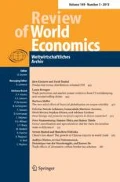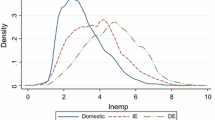Abstract
This article studies the joint destination and product strategies of exporters, using the universe of export transactions for firms located in Portugal in the period 1995–2005. The article breaks down the annual growth rate of total exports along different margins and details choices made by multi-product, multi-destination firms regarding their export portfolio. In addition, the article looks at similar features for the subsample of new exporters. We find that both the firm-level extensive and intensive margins are important in driving the year-to-year variation in aggregate exports. However, variation over time in the sales of continuing exporters is mainly driven by their sales in continuing destinations. In addition, a product’s export tenure within a firm varies largely across currently exported products in the context of an intense activity of product and destination switching. Moreover, the higher the importance of a product, the more its sales are concentrated in the firm’s top destination. Finally, the article finds that, while continuing exporters enter new markets mainly by selling old products, new exporters access new destinations mainly by exporting new products.






Similar content being viewed by others
Notes
In a previous version of this article, which has circulated under the same name, the set of firms included in the analysis accounted for all merchandize exporters and not just those that belong to the manufacturing sector, i.e., it included services firms that export goods (notably retailers and wholesalers). In this context, we find that the intensive margin in the firm dimension explains a larger share of the year-to-year growth rate of aggregate exports.
Manufacturing firms were identified using a sectoral classification, by crossing trade data with a matched employer-employee data set for the same time period. For details see Martins and Opromolla (2011).
The CN system is comprised of the harmonized system (HS) nomenclature with further European Community subdivisions. The HS is run by the World Customs Organization. This classification of commodities is used by most trading nations and in international trade negotiations. The first 6-digits of the CN system approximately coincide with the HS classification. While the CN system is changed almost every year, the HS, created in 1988, was updated on January 1st 1996, January 1st 2002 and January 1st 2007. The adjustments were made at the 6-digit level and implied the aggregation of some categories.
As Eaton et al. (2007) explain, computing growth as the change between two dates divided by the average level in the two dates rather than the change divided by the level in the earlier date has at least two advantages: (i) x percent growth followed by −x percent growth returns us to the same level and (ii) values close to zero in the first year have a less extreme effect on the growth rate.
In this section most results are reported for the reference period 1996–2005. As a robustness test, the calculations were performed separately for the years 1998, 2000 and 2003 and the stylized facts presented hold. Robustness tests regarding product switching by Portuguese exporters were also performed.
The fact that exports from multi-product firms are concentrated in the top product categories is also reported by Hummels et al. (2011) using Danish data. The author refers that 59 % of exports come from the top two categories and 77 % from the top five categories, using a product disaggregation at the 6-digit of the HS.
They define a product as a 10-digit HS code.
The OLS estimate of the elasticity between product (destination) rank and product (destination) size is −0.38 (−0.40), with an R 2 of 0.95 (0.95).
Table 9 shows that the top three products, for firms with a product scope between 11 and 50, account for almost 87 % of total exports.
The level of vertical specialization is similar in both countries, potentially yielding a similar impact from exports of parts and inputs; the existence of pure intermediation is more likely when international distribution channels are costlier and firms are smaller, as it is the case in Portugal; complementary is possible in all categories of goods, i.e., it is not directly affected by specialization patterns; brands are stronger in Belgium, potentially increasing the strength of this explanation for carry-along trade in this country.
References
Albornoz, F., Calvo-Pardo, H., Corcos, G., & Ornelas, E. (2012). Sequential exporting. Journal of International Economics, 88(1), 17–31.
Arkolakis, C. (2009). A unified theory of firm selection and growth (CESifo working paper 2679). Munich: Ifo Institute for Economic Research.
Arkolakis, C., & Muendler, M. (2011). The extensive margin of exporting goods: A firm-level analysis. Mimeo.
Bernard, A. B., Redding, S., & Schott, P. K. (2011). Multi-product firms and trade liberalization. The Quarterly Jounal of Economics, 126(3), 1271–1318.
Bernard, A., Beveren, I., Blanchard, E., & Vandenbussche, H. (2012). Carry-along trade (NBER Working Paper 18246). Cambridge, MA: National Bureau of Economic Research.
Bernard, A., Jensen, J., Redding, S., & Schott, P. (2007). Firms in international trade. Journal of Economic Perspectives, 21(3), 105–130.
Bernard, A., Jensen, J., & Schott, P. (2009). Importers, exporters and multinationals: A portrait of firms in the US that trade goods. In: T. Dunne, J. B. Jensen & M. J. Roberts (Eds.), Producer dynamics: New evidence from micro data (Chap. 14, pp. 513–552). Cambridge, MA: National Bureau of Economic Research.
Bernard, A., Redding, S., & Schott, P. (2010). Multi-product firms and product switching. The American Economic Review, 100(1), 70–97.
Békés, G., Muraközy, B., & Harasztosi, P. (2011). Firms and products in international trade: Evidence from Hungary. Economic Systems, 35(1), 4–24.
Cabral, L., & Mata, J. (2003). On the evolution of the firm size distribution: Facts and theory. American Economic Review, 93(4), 1075–1090.
Eaton, J., Eslava, M., Jinkins, D., Krizan, C. J., & Tybout, J. (2012). A search and learning model of export dynamics. Mimeo.
Eaton, J., Eslava, M., Kugler, M., & Tybout, J. (2007). Export dynamics in Colombia: Firm-level evidence (NBER Working Paper 13531). Cambridge, MA: National Bureau of Economic Research.
Eaton, J., Kortum, S., & Kramarz, F. (2004). Dissecting trade: Firms, industries and export destinations. American Economic Review: Papers and Proceedings, 94(2), 150–154.
Eaton, J., Kortum, S., & Kramarz, F. (2011). An anatomy of international trade: Evidence from French firms (NBER Working Paper 14610). Cambridge, MA: National Bureau of Economic Research.
Fabling, R., Grimes, A., & Sanderson, L. (2011). Whatever next? Export market choices of New Zealand firms. Papers in Regional Science, 91(1), 137–159.
Görg, H., Kneller, R., & Murakozy, B. (2007). What makes a successful export? (CEPR Discussion Paper No. 6614). London: Centre for Economic Policy Research.
Hopenhayn, H. A. (1992). Entry, exit, and firm dynamics in long run equilibrium. Econometrica, 60(5), 1127–1150.
Hummels, D., Jøgensen, R., Munch, J., & Xiang, C. (2011). The wage effects of offshoring: Evidence from Danish matched worker-firm data (NBER Working Paper 17496). Cambridge, MA: National Bureau of Economic Research.
Iacovone, L., & Javorcik, B. (2010). Multi-product exporters: Product churning, uncertainty and export discoveries. The Economic Journal, 120(544), 481–499.
Irarrazabal, A. A., & Opromolla, L. D. (2008). A theory of entry into and exit from export markets (Working Paper 20). Banco de Portugal.
Jovanovic, B. (1982). Selection and the evolution of industry. Econometrica, 50(3), 649–670.
Lederman, D., Rodríguez-Clare, A., & Xu, D. Y. (2011). Entrepreneurship and the extensive margin in export growth: A microeconomic accounting of Costa Rica’s export growth during 1997–2007. World Bank Economic Review, 25(3), 543–561.
Luttmer, E. G. (2007). Selection, growth and the size distribution of firms. Quarterly Journal of Economics, 122(3), 1103–1144.
Manova, K., & Zhang, Z. (2009). China’s exporters and importers: Firms, products and trade partners (CEPR Discussion Paper No.15249). London: Centre for Economic Policy Research.
Martins, P. S., & Opromolla, L. D. (2011). Why ex(im)porters pay more: Evidence from matched firm-worker panels (Working Paper 23). Banco de Portugal.
Mayer, T., & Ottaviano, G. P. (2008). The happy few: The internationalisation of European firms. Intereconomics: Review of European Economic Policy, 43(3), 135–148.
Melitz, M. J. (2003). The impact of trade on intra-industry reallocations and aggregate industry productivity. Econometrica, 71(6), 1695–1725.
Muûls, M., & Pisu, M. (2009). Imports and exports at the level of the firm: Evidence from Belgium. The World Economy, 32(5), 692–734.
Wagner, J. (2012a). German multiple-product, multiple-destination exporters: Bernard–Redding–Schott under test. Economics Bulletin, 32(2), 1708–1714.
Wagner, J. (2012b). International trade and export performance: A survey of empirical studies since 2006. Review of World Economics, 148(2), 235–268.
Wagner, J. (2012c). The post-entry performance of cohorts of export starters in German manufacturing industries. International Journal of the Economics of Business, 19(2), 169–193.
Yeaple, S. R. (2005). A simple model of firm heterogeneity, international trade, and wages. Journal of International Economics, 65(1), 1–20.
Acknowledgments
We thank Maria Lucena Vieira for excellent research assistance, INE (Statistics Portugal) for providing the trade data and Salvador Gil and Cristina Neves for continuous assistance in building the data set. For their suggestions and comments, we also wish to thank participants of seminars at CRENOS-Cagliari, CORE, ETSG 2008—Warsaw, 2nd Annual Meeting of the Portuguese Economic Journal—Évora 2008, ISS conference: Productivity and Internationalisation: A Micro-Data Approach—The Hague 2010 and 6th ISGEP Workshop—Lüneburg 2011, as well as two anonymous referees. Luca David Opromolla acknowledges financial support from Portuguese national funds by FCT (Fundação para a Ciência e a Tecnologia). This article is part of the Strategic Project: PEst-OE/EGE/UI0436/2011. The opinions expressed are those of the authors and not necessarily those of Banco de Portugal.
Author information
Authors and Affiliations
Corresponding author
About this article
Cite this article
Amador, J., Opromolla, L.D. Product and destination mix in export markets. Rev World Econ 149, 23–53 (2013). https://doi.org/10.1007/s10290-012-0136-z
Published:
Issue Date:
DOI: https://doi.org/10.1007/s10290-012-0136-z




